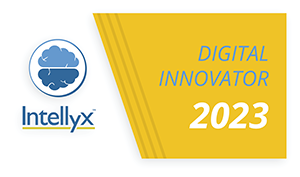 Today is an exciting day, as we announce our final batch of 2023 Intellyx Digital Innovator Award winning vendors. We love recognizing vendors for having solutions that are interesting enough to talk about, but that’s all we require to take a briefing or issue these awards—since we never rank vendors or put them into our own preferred categories.
Today is an exciting day, as we announce our final batch of 2023 Intellyx Digital Innovator Award winning vendors. We love recognizing vendors for having solutions that are interesting enough to talk about, but that’s all we require to take a briefing or issue these awards—since we never rank vendors or put them into our own preferred categories.
As analysts, we are asked one question quite a bit, especially when we’re at a show, waiting for a breakout session or having lunch with some end customers we haven’t met yet:
Which solution is the best?
Unfortunately, I don’t believe that I or even a smarter analyst than myself could properly answer this question. Unless you are asking about a technology space where there basically is no competition or the distinctions don’t matter anymore—for instance, selecting an IDE (use VSCode or Eclipse, or whatever else works for your developers is fine).
The problem here is, the ideal solution for any strategically important need will rapidly change over time, depending upon the current size and objectives of the end customer’s engineering teams, and the current state of consolidation in the market.
Why ROI is overrated
It’s easy to get “addicted to the ROI crack pipe” when making technology decisions as my friend and renowned tech evangelist Miko Matsumura would say at conferences.
The point being, when you break a software investment down to cost inputs and revenue outputs, much like a corporation that is only concerned about quarter-to-quarter EBITDA financial statistics, you miss out on realizing the long-term value of employee recruitment and retention, returning customers, and innovation into as-yet-undiscovered areas.
Most analyst evaluations take in some reported customer metrics—and the data is skewed because it would behoove those leaders to highlight the value of the decisions they made.
This approach might miss the forest for the trees, and predict an ROI somewhere around 200% because anything less seems insignificantly small. And, anything much bigger than double value seems laughable too, as if this new platform magically pays for itself, as well as the implementation cost, and training labor, and services required for migration and adoption.
Faced with this challenge, review boards and CIO offices sometimes insist on ‘hard dollar’ cost savings figures such as cloud bill reductions, or lower MTTR time spent on incidents, which doesn’t attribute successes to the technology change, nor incentivize positive growth.
This is not to say that ROI isn’t important, but I do believe predicted value is only one-third of the reason for selecting any solution, and should share the spotlight with technical requirements and vendor alignment.
Requirements come standard
Requirements remain the natural starting point of every technology consideration lifecycle.
There would never be a reason for departing from the status quo if an enterprise’s technical estate didn’t have technical shortcomings. The system would not scale or perform under pressure, or the data is getting hacked, or customers are leaving because of unmet expectations in services, price, or features.
Modernization requirements arise because the organization keeps accruing technical debt by patching up existing systems over the years. Technical architectures start out flexible, then become uniquely brittle and interdependent monoliths. Even if distributed cloud services are used, a shrinking set of dominant vendors buys fledgling startups and overtakes major competitors, in order to check the boxes in their solution set and eliminate the likelihood of customer churn.
Ultimately this results in fewer meaningful vendor choices, a dilemma I’ve discussed in a previous Cortex. But there is a silver lining here. While an 800-pound gorilla dictates its own price and sets the agenda for their market, this also encourages nimbler vendors and well-intentioned open source projects to reinvent the market by obsessively focusing on one feature at a time.
Since we don’t rank or compare vendors, we built our own Intellyx Profiler™ to help companies prioritize requirements around their enterprise’s primary goals.
For instance, if developer productivity is vitally important to keeping an online bank ahead of a fast-changing fintech market, a team might value collaboration and DORA metrics, and seek out platform engineering solutions that enable self-service provisioning and automated releases, with scalability in production.
Whereas an organization such as an airline or healthcare firm that has had a high-profile system wide failure or fallen prey to a ransomware attack might care more about operations insight, data protection and resiliency.
This doesn’t mean criteria like security or scalability can just be dismissed if they aren’t the top priority. They may have baseline requirements that must be met to qualify, even if other aspects are primary differentiators.
Mutual alignment on vision
Technology selections are not dissimilar to elections—they are often decided by emotional factors like comfort level, or the fear of failure.
 We can discard some of these gut-level checks, in favor of trusting the more intellectual pursuit of shared perspectives. As a buyer, you also need to buy into the vision of the vendor or solution you select, because where their leaders see their organization and products evolving in the next 3 to 5 years should match up with your technical vision for the company.
We can discard some of these gut-level checks, in favor of trusting the more intellectual pursuit of shared perspectives. As a buyer, you also need to buy into the vision of the vendor or solution you select, because where their leaders see their organization and products evolving in the next 3 to 5 years should match up with your technical vision for the company.
If the vendor’s content is good, it should immediately give you a window into their own priorities going forward. A commercial open source company or deeply technical vendor will do this largely through blogs and developer relations activity, whereas a bigger vendor, you might look for both mid-level demonstrations and executive keynotes in your research.
Alignment can be difficult to maintain when larger companies with very complete solutions are acquired, like for instance, when AppDynamics was acquired by Cisco, and then later, Cisco also acquired Splunk, who also has a very mature observability platform. Which form of observability will go forward, and which one will ride off into the sunset with its thought leaders?
The Intellyx Take
I’ve now worked on all three sides of this selection process: as an analyst, as a technology buyer, and as a marketing leader for a vendor.
As a vendor, I would be astounded when a prospective customer would ask me to do their due diligence homework for them—when I already had a clear responsibility to accentuate my own solution’s advantages versus the disadvantages of others.
So who should you turn to for help? Isn’t picking a winner among various technologies basically the analyst’s main job?
As analysts, we’re here to help you sort through the hype and vendor claims, and hopefully our writing is useful in determining your own value goals, selection criteria, and shared vision for the future.
Now get out there, get clearance, and prepare for takeoff!
Copyright ©2023 Intellyx B.V. Intellyx is an industry analysis and advisory firm focused on enterprise digital transformation. Covering every angle of enterprise IT from mainframes to artificial intelligence, our broad focus across technologies allows business executives and IT professionals to connect the dots among disruptive trends. As of the time of writing, none of the organizations mentioned in this article is an Intellyx customer. No AI chatbot was used to write this article. Image credit: Adobe Express Image.



